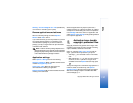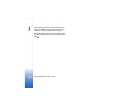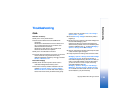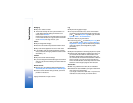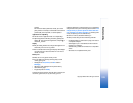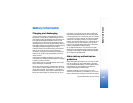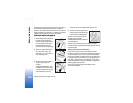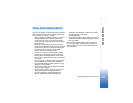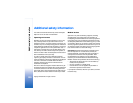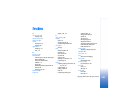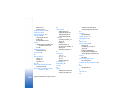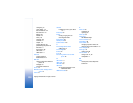
Additional safety information
127
Copyright © 2005 Nokia. All rights reserved.
To make an emergency call:
1 If the device is not on, switch it on. Check for adequate
signal strength.
Some networks may require that a valid SIM card is
properly inserted in the device.
2 Press the end key as many times as needed to clear the
display and ready the device for calls.
3 Enter the official emergency number for your present
location. Emergency numbers vary by location.
4 Press the the call key.
If certain features are in use, you may first need to turn those
features off before you can make an emergency call. Consult
this guide or your service provider for more information.
When making an emergency call, give all the necessary
information as accurately as possible. Your wireless device
may be the only means of communication at the scene of an
accident. Do not end the call until given permission to do so.
Warning: In the offline profile you cannot make (or
receive) any calls, except make calls to certain emergency
numbers, or use other features that require network
coverage.
Warning: You cannot make emergency calls in the
Imaging mode, because the keypad is not active. To make
an emergency call, activate the Fold open mode.
Certification information (SAR)
THIS DEVICE MEETS INTERNATIONAL GUIDELINES FOR
EXPOSURE TO RADIO WAVES
Your mobile device is a radio transmitter and receiver. It is
designed and manufactured not to exceed the limits for
exposure to radio frequency (RF) recommended by
international guidelines (ICNIRP). These limits are part of
comprehensive guidelines and establish permitted levels of RF
energy for the general population. The guidelines were
developed by independent scientific organizations through
periodic and thorough evaluation of scientific studies. The
guidelines include a substantial safety margin designed to
assure the safety of all persons, regardless of age and health.
The exposure standard for mobile devices employs a unit of
measurement known as the Specific Absorption Rate, or SAR.
The SAR limit stated in the international guidelines is 2.0
watts/kilogram (W/kg)
*
. Tests for SAR are conducted using
standard operating positions with the device transmitting at
its highest certified power level in all tested frequency bands.
Although the SAR is determined at the highest certified power
level, the actual SAR of the device while operating can be well
below the maximum value. This is because the device is
designed to operate at multiple power levels so as to use only
the power required to reach the network. In general, the closer
you are to a base station, the lower the power output of the
device.
The highest SAR value for this device when tested for use at
the ear is 0.29 W/kg.



